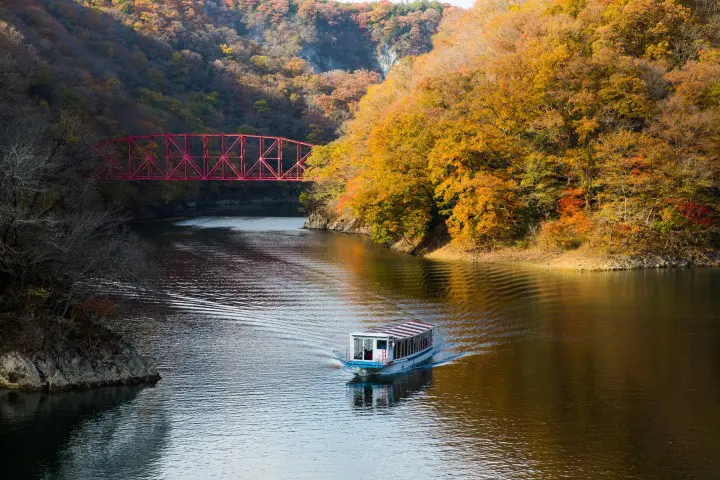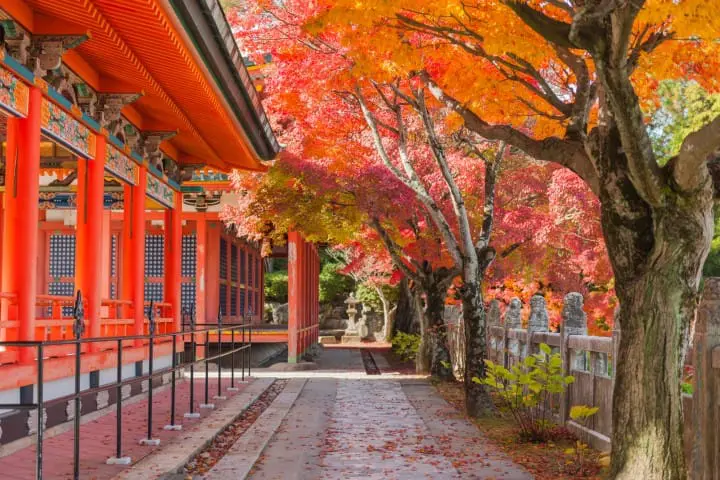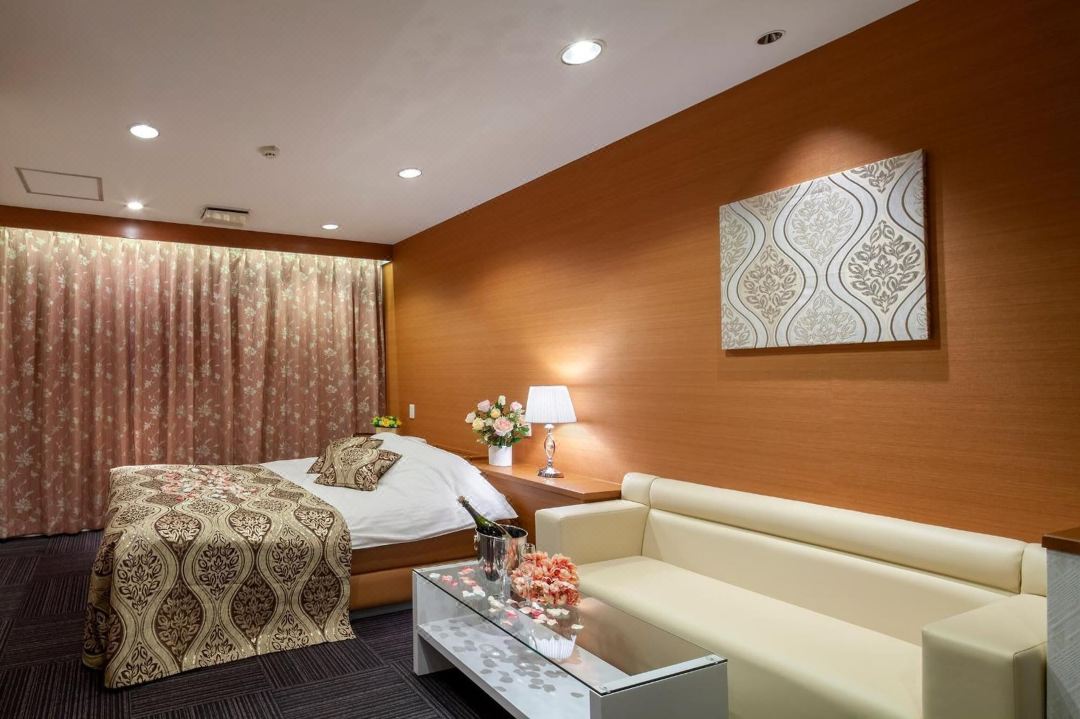Hiroshima and Miyajima: Top 10 Autumn Foliage Spots in 2025

Hiroshima's famous destinations include Miyajima Island and the Peace Memorial Park. Learn 10 beautiful fall foliage spots in Hiroshima and the best time to visit.
Enjoy Autumn in Hiroshima

2025 fall foliage map based on information from Weathernews
In addition to famous travel destinations such as Miyajima Island and the Peace Memorial Park, Hiroshima boasts parks and gardens with beautiful fall foliage, which can be enjoyed from late October until mid-November.
When planning a visit, please keep in mind that the average temperature in November is about 12°C to 13°C (53.6°F to 55.4°F) so pack a light jacket or cardigan to stay comfortable.
Read on to learn about ten locations in Hiroshima with splendid fall foliage and the best time for viewing them.
Top 10 Beautiful Autumn Foliage Spots in Hiroshima
1. Momijidani Park (Miyajima Island)
2. Taishakukyo Valley (Jinseki)
3. Buttsuji Temple (Mihara)
4. Fudoin Temple (Hiroshima)
5. Shukkeien Garden (Hiroshima)
6. Kosanji Temple (Onomichi)
7. Hiroshima Memorial Peace Park
8. Daishoin Temple (Miyajima Island)
9. Sankeien Garden (Mihara)
10. Ozekiyama Park (Miyoshi)
Read also
1. Momijidani Park on Miyajima Island: Superb Views of Fall Foliage

Photo by Pixta
Momijidani Park is a picturesque park located at the foot of the Misen Primeval Forest on Miyajima. There are approximately 700 momiji maple trees, ushering in thousands of visitors annually for fall foliage viewing.
The view of these trees with Momijibashi Bridge in the background makes for a postcard-like scene. Admission to the park is free.
Mount Misen is located nearby and accessible by a ropeway. To reach the summit for stunning fall views of Itsukushima Shrine's red torii gate, take the Miyajima Ropeway from Momijidani Station. It is just ten minutes on foot from Momijidani Park. Get off at Shishi-Iwa Station and walk 30 minutes to the summit of Mt. Misen. The hike to the top is a one-of-a-kind experience paired with crisp fall temperatures and bright leaves.
Return tickets for the ropeway are 1,800 yen for adults and 900 yen for children. The ropeway operates from 9:00 to 18:00 in November when you can best enjoy the autumn scenery.
Fall Foliage Viewing Time
You can see the fall foliage from mid-November until late November.
Getting to Momijidani Park
Address: Hiroshima, Hatsukaichi, Miyajima, Momijidani Google Map
Access: From the Miyajimaguchi Pier, it’s a ten-minute boat ride to the Miyajima Ferry Terminal. Momijidani Park is about a 20-minute walk from the ferry terminal.
Hotels near Momijidani Park
↑ Return to the top of article.
2. Taishakukyo Valley in Jinseki: Autumn Views in Northern Hiroshima

Picture courtesy of Hiroshima Prefecture
Taishakukyo Valley, located in Hiroshima Prefecture’s northeastern area, is a famous 18-kilometer-long ravine, occupying the Taishakukyo River basin and Shinryu Lake. It is especially famous for its stunning colors in fall, as the surrounding hillsides and mountains are reflected in bright blue waters.
If you visit the area, try kayaking down the river or riding a pleasure boat that takes visitors on a scenic 40-minute tour of Shinryu Lake. While on the boat, you can admire the nearby mountains up close.
The pleasure boat operates from 9:00 until 16:30, from mid-March to mid-December. Boats depart every 30 minutes, and fares cost 1,500 yen for adults and 750 yen for children.
Kayaking is around 4,000 yen per person for 90 minutes (an advanced reservation of two days or more is required. Please check the official website for details).
Fall Foliage Viewing Time
The fall foliage can be enjoyed from late October to mid-November.
Getting to Taishakukyo
Address: Hiroshima, Jinseki, Jinsekikogen, Nagano 5034-7 (Pleasure Boat Terminal) Google Map
Access: To access the Shinryu Lake area, where the pleasure boat terminal is located, take a 20-minute taxi ride from Tojo Station (Geibi Line).
There’s also a bus service. However, there are only four daily departures on weekdays, and the service isn’t available on weekends and holidays. Therefore, we recommend heading here by taxi. The one-way fare is about 3,000 yen.
Official Website: http://taishakukyo.com/
Hotels near Taishakukyo Gorge
3. Buttsuji Temple in Mihara: A Famous Fall Spot

Picture courtesy of Hiroshima Prefecture
Buttsuji is a temple housing one of Japan’s foremost Zen Buddhist training halls. It was constructed amidst nature, and filled with momiji and kaede maple trees, making this a famous spot for marveling at autumn leaves. In the fall, the area comes alive with many sightseers.
Additionally, the area is illuminated in the evening in November. The scenic beauty stands out even more while looking at foliage alongside the temple and Buddhist statues.
During the fall, admission to the temple is around 300 yen for adults and about 200 yen for students (junior high school and up). Elementary school students are admitted free of charge.
Forecasted Fall Foliage Viewing Time
The fall foliage can be enjoyed from early November to mid-November.
Getting to Buttsuji Temple
Address: Hiroshima, Mihara, Takasaka, Motoyama Google Map
Access: From Mihara Station, take a bus headed for Buttsuji Temple and get off at the last stop. The trip takes about 40 minutes. You can also take a bus headed for Buttsuji Temple from Hongo Station and get off at the final stop. The ride takes 30 minutes.
Official Website: http://www.buttsuji.or.jp/ (Japanese)
↑ Return to the top of article.
4. Fudoin Temple in Hiroshima: Fall Foliage at a Historic Site

Picture courtesy of Hiroshima Prefecture
Fudoin Temple is one of Hiroshima's most historical sites. The bronze statues on the premises are thought to date back as far as the Heian Period (794-1185). It’s a precious temple blessed with important cultural assets designated by the Japanese government, including the main hall.
Admission to the temple is free of charge. The sight of red leaves alongside the main hall symbolizes Japan’s classic autumn scenery. Additionally, Fudoin Temple is bustling with visitors during spring when the cherry blossoms are in full bloom.
Forecasted Fall Foliage Viewing Time
The fall foliage can be enjoyed from mid-November to early December.
Getting to Fudoin Temple
Address: Hiroshima, Higashi, Ushitashin 3-4-9 Google Map
Access: From Hiroshima Station, it’s a 15-minute train ride via the Hiroshima Electric Railway to Hondori Station. Transfer to the Astram Line (Hiroshima Rapid Transit) and get off at Fudoin-mae Station (a 10-minute ride). The temple is just a short walk from here.
Official Website: http://www.megaegg.ne.jp/~fudouin/index.html (Japanese)
↑ Return to the top of article.
5. Shukkeien Garden in Hiroshima: Marvelous Fall Foliage in the Heart of the City

Picture courtesy of Hiroshima Prefecture
Shukkeien Garden was selected among the top 100 historic gardens in Japan. This beautiful Japanese garden looks like a painting in the fall. The reflection of the foliage on the pond's surface at Shukkeien is breathtakingly beautiful.
During the fall foliage festival every November, the leaves are illuminated at night and create a mystical atmosphere.
The garden is open from 9:00 to 17:00 (last entry at 16:30). Admission is 260 yen for adults, 150 yen for high school and university students, and 100 yen for elementary school and junior high school students.
Fall Foliage Viewing Time
The fall foliage can be viewed from mid-November until early December.
Getting to Shukkeien Garden
Address: Hiroshima, Naka, Kaminobori 2-11 Google Map
Access: Fifteen minutes on foot from Hiroshima Station.
Official Website: http://shukkeien.jp/ (Japanese)
Hotels near Shukkeien Garden
↑ Return to the top of article.
6. Kosanji Temple in Onomichi: Island Scenery and Fall Colors

Kosanji is a Buddhist temple in Onomichi located on Ikuchijima Island. Visitors will find numerous designated national treasures on the grounds, like a 15-meter pagoda and a 10-meter-tall Buddha statue. Vivid red and yellow leaves color the area come fall. The combination of these historic structures and colors is a must-see!
Besides fall foliage, Kosanji Temple has a museum that visitors can enjoy. Sculptures, paintings, and other centuries-old artifacts dating back to the Heian and Kamakura (1185-1333) periods will dazzle museum-goers. There are also cultural events and festivals that occur regularly on the premises.
By planning an afternoon or morning here, you can take in the stunning autumn scenery and rich history.
Fall Foliage Viewing Time
The fall foliage can be enjoyed here from mid-November to early December.
Getting to Kosanji Temple
Address: Hiroshima, Onomichi, Setoda, Setoda 553-2
Access: You must take a ferry to reach Ikuchijima Island, where Kosanji is located. The most convenient method is boarding a boat that departs from Onomichi Port. Take the Setouchi Cruise and get off at Setoda. The ride takes a little over 30 minutes. Since boats are limited, please check the official schedule.
Official Website: http://www.kousanji.or.jp/english/
↑ Return to the top of article.
7. Hiroshima Memorial Peace Park

Photo by Pixta
Situated in the heart of Hiroshima, the Hiroshima Memorial Peace Park is a solemn yet beautiful memorial dedicated to the victims of the atomic bomb dropped in 1945.
In autumn, the park transforms into a vibrant tapestry of colors, with ginkgo trees prominently showcasing their striking yellow leaves and maple trees adding pops of vibrant reds to the park.
The contrast of these vibrant golden leaves against the park's somber historic monuments, such as the A-Bomb Dome and the Peace Memorial Museum is truly a sight to see and a great example of how a city once devastated has bounced back flourishing with natural beauty.
One of the best places to enjoy the autumn foliage is from Orizuru Tower, an observatory deck that offers stunning panoramic views of the park. From here, visitors can admire the beauty of the autumn leaves while gaining insights into the park's significance.
Fall Foliage Viewing Time
The fall foliage can be viewed from mid-November until early December.
Hotels near Peace Memorial Park
Read also
↑ Return to the top of article.
8. Daishoin Temple

Photo by Pixta
Daishoin Temple is a serene Buddhist temple located on Miyajima Island, just a short ferry ride from Hiroshima. Established in 806 AD by the famous monk Kobo Daishi (Kukai), the temple has a rich history and serves as an important center for the Shingon sect of Buddhism.
Nestled at the foot of Mount Misen, the temple grounds are adorned with beautiful gardens, intricate statues, and several impressive halls, including the main hall and stunning hanging lanterns, both reflecting traditional Japanese architectural styles.
During the fall, the vibrant red and orange leaves of the maple trees create a breathtaking contrast against the temple's architecture, enhancing the site's beauty and tranquility.
The combination of natural splendor and spiritual heritage makes Daishoin Temple a special destination for visitors seeking both peace and picturesque landscapes. The temple is also home to many unique features, including a collection of beautiful lanterns, a small shrine dedicated to the deity of wisdom, and a hall with one thousand Buddhist arhat statues.
Fall Foliage Viewing Time
The fall foliage can be viewed from mid-November until early December.
Hotels near Daisho-in Temple
↑ Return to the top of article.
9. Sankeien Garden in Mihara

Photo by Pixta
A tranquil escape from the hustle and bustle of the city, Mihara's Sankeien Garden is a beautiful landscape with stunning ponds, walking trails, and a variety of seasonal flowers and trees.
Established in 1993 near Hiroshima Airport, the garden is conveniently located just a five-minute walk from the terminal.
Designed with the natural beauty of Hiroshioma in mind, the garden is split into three sections to explore, each showcasing the region's incredible landscapes, from the prefecture's mountainscapes and rolling valleys to its beautiful outlook on the Seto inland sea, depicted at the gardens Oumi Pond!
In autumn, visitors are treated to a vibrant tapestry of colors as maple and ginkgo trees transform the landscape into shades of red and gold, creating a breathtaking backdrop for relaxation and reflection.
The garden also features historic structures, including the charming teahouse Chokentei and traditional pagodas. With winding pathways, koi carp, and shimmering autumn leaves, Sankeien Garden is a must-visit when in Hiroshima.
Fall Foliage Viewing Time
The fall foliage can be viewed from mid-November until early December.
Location: Hiroshima, Mihara, Hongocho Zennyuji 64-24 Map
↑ Return to the top of article.
10. Ozekiyama Park

Photo by Pixta
Ozekiyama Park is a beautiful scenic retreat located in Hiroshima, beloved in spring for its cherry blossoms and incredible in autumn for its stunning fall foliage.
Nestled at the base of Mt. Ozeki, the park features well-maintained walking trails that invite exploration of its lush landscapes. In autumn, Ozekiyama Park becomes a breathtaking spectacle as the maple trees ignite in brilliant shades of red, orange, and yellow.
The peaceful atmosphere, paired with panoramic views from its observatory deck overlooking Miyoshi City and the surrounding mountains, makes it an ideal setting for leisurely strolls and photography.
Named after Ozeki Masakatsu, a samurai who built his castle in the area during the Edo period, the park is rich in history, featuring statues and references to notable figures like poet Nakamura Kenkichi and Princess Akuri. With its picnic areas and playgrounds, Ozekiyama Park is perfect for families, offering a delightful escape into nature amidst stunning autumn colors.
Fall Foliage Viewing Time
The fall foliage can be viewed from early to mid-November.
Location: Miyoshimachi, Miyoshi, Hiroshima Map
↑ Return to the top of article.
FAQ
When to see autumn leaves in Hiroshima?
Autumn foliage, or "koyo," in Hiroshima typically peaks around mid to late November. During this time, the leaves of the maple trees and other foliage across the city transition into beautiful shades of red, orange, and yellow, creating a stunning backdrop against Hiroshima's historical and modern attractions. To catch the best of the autumn leaves in Hiroshima, it is recommended to plan your visit during the mid to late November period. However, like other regions, the exact timing can vary each year based on factors like temperature and weather conditions. Keeping an eye on local forecasts and updates closer to your intended visit date can help ensure you witness the breathtaking autumn foliage at its peak in Hiroshima.
When to see autumn leaves in Miyajima?
In Miyajima, an island known for its iconic "floating" torii gate and Itsukushima Shrine, the autumn foliage season typically peaks around mid-November to early December. During this time, the maple trees on the island turn vibrant shades of red and orange, creating a stunning contrast against the island's natural and cultural landscapes. To experience the best of the autumn leaves in Miyajima, it is advisable to plan your visit during this mid to late November period, when the colors are usually at their most vibrant. However, as with any natural phenomenon, the exact timing can vary slightly each year, so checking updated reports and forecasts closer to your trip can help ensure you witness the breathtaking beauty of the fall foliage on Miyajima Island.
How to get from Hiroshima to Miyajima Island?
Traveling from Hiroshima to Miyajima Island is easily accomplished using multiple transportation options. Visitors can opt for a convenient train and ferry combination by taking a short JR Sanyo Line train ride from Hiroshima Station to Miyajimaguchi Station, followed by a brief walk to the ferry terminal for a quick 10-minute ferry ride to Miyajima Island. An alternative route involves using the Hiroshima Electric Railway (Hiroden) tram system, transferring to the Miyajima Line at Hiroden-Honsha-mae Station, and boarding a ferry from Miyajimaguchi to the island. For a direct journey, there is also a ferry service available from Hiroshima Peace Park, near the Atomic Bomb Dome, directly to Miyajima Island, providing a scenic 45-minute voyage to this iconic destination. These transportation options offer convenient and efficient ways to access the picturesque Miyajima Island from Hiroshima, ensuring a seamless and enjoyable travel experience to explore the island's natural beauty and cultural wonders.
Is it worth visiting Miyajima?
A visit to Miyajima, or Itsukushima Island, is highly recommended for its iconic floating torii gate at the Itsukushima Shrine, symbolizing the fusion of nature and humanity. With a rich cultural and historical heritage, including UNESCO World Heritage sites, Miyajima offers visitors a profound sense of Japan's past. The island's scenic beauty is unparalleled, featuring lush forests, hiking trails up Mount Misen for breathtaking views, and serene spots like Momijidani Park during autumn's colorful foliage season. Miyajima's wildlife, including friendly deer, adds to the island's charm, while opportunities for birdwatching, beach walks, and appreciation of nature abound. Culinary enthusiasts can savor fresh seafood delights, notably oysters, and local specialties such as grilled oysters and Momiji Manju cakes. Combining natural splendor, cultural significance, iconic landmarks, and delectable cuisine, Miyajima stands as a captivating destination offering a multifaceted experience for travelers exploring Hiroshima's vicinity.
How many days to see Hiroshima?
The ideal duration to explore Hiroshima ranges from 2 to 3 days to fully appreciate its key attractions like the Hiroshima Peace Memorial Park, the Atomic Bomb Dome, Miyajima Island with the Itsukushima Shrine, and Hiroshima Castle. For a more comprehensive experience that includes deeper exploration, relaxation, and potential visits to nearby areas like Okayama or Kurashiki, allocating 4 to 5 days allows for a more leisurely and immersive visit to Hiroshima. Travelers should consider the travel time between locations and the pace at which they wish to explore each site to tailor their itinerary to their interests, ensuring a rewarding and in-depth experience of the city's history, culture, and natural beauty.
Enjoy the Fall Foliage in Hiroshima
Autumn offers numerous ways to enjoy the picturesque scenery and different areas in Hiroshima. From famous Miyajima to lesser-known spots, this prefecture is full of scenic attractions and new experiences to be enjoyed on crisp autumn days.
Read also
Main image by Pixta
This is the official account of MATCHA's editorial department. Our articles feature useful travel information for visitors to Japan, from how-to guides to recommended places to visit.






















![[Okinawa Driving Course] Experience the mystical nature and experience something out of the ordinary on this trip!](https://resources.matcha-jp.com/resize/200x2000/2024/06/03-182449.webp)












































![[2026] A walking map of famous plum blossom spots in Osaka!](https://resources.matcha-jp.com/resize/720x2000/2025/12/22-253767.webp)

